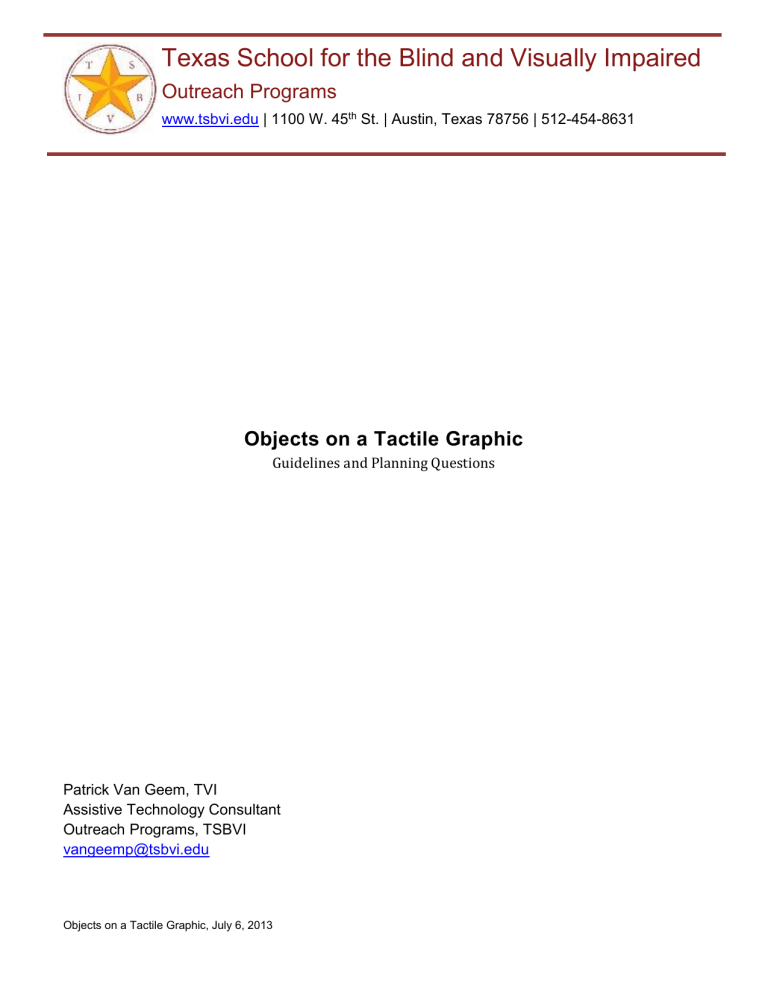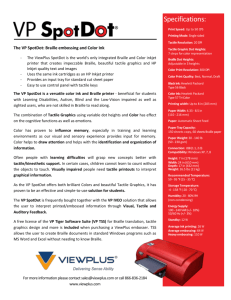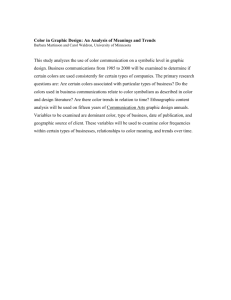Object Components of Tactile Graphics

Texas School for the Blind and Visually Impaired
Outreach Programs
www.tsbvi.edu
| 1100 W. 45 th St. | Austin, Texas 78756 | 512-454-8631
Objects on a Tactile Graphic
Guidelines and Planning Questions
Patrick Van Geem, TVI
Assistive Technology Consultant
Outreach Programs, TSBVI vangeemp@tsbvi.edu
Objects on a Tactile Graphic, July 6, 2013
Contents
General Tactile Graphics Design Principles
Identify the key message in the original visual image. What is the essential information that needs to be conveyed in the tactile image? This will highlight all of the elements which can be excluded from the tactile image without losing important information
.
Detail which may add interest for a sighted viewer of a mainstream image but is not actually conveying any important information needs to be removed from a tactile image.
It is important that the designer considers visual concepts like perspective, occlusion and transparency which are best removed as they can distort information trying to be conveyed.
Usually the tactile image will be larger than its mainstream equivalent. It should not, however, be too large. This would make the various well-spaced out components difficult to relate to each other.
With sight we can perceive very small items, like a full stop in printed material. It is easy for a sighted person to distinguish the difference between quite small symbols - a couple of millimeters across. The difference between the symbols could be quite subtle - a square and a pentagon but still differentiable. However for a blind or partially sighted person the smallest tactual perception possible is roughly the size of a fingertip.
An open square and circle 6 mm across are tactually very difficult to tell apart so a designer will need to verify that the symbols selected for their image are appropriate.
Objects on a Tactile Graphic, July 6, 2013
Basic Principles for Preparing Tactile Graphics
Source: American Foundation for the Blind Braille Literacy Mentors in Training: The Next Generation -
Teaching Special Codes: Nemeth, CBC, and Tactile Graphics - Workshop in Fremont, California (August
7-9, 1997) and Atlanta, Georgia (September 11-13, 1997). Diane Spence and Susan A. Osterhaus
Make the tactile graphic as clear as possible . Always keep in mind the point of view of the braille reader. It is up to the producer to present the information in a clear, concise manner for the student.
Know the important facts to be kept in mind when creating the graphic.
Determine if the original shapes and textures are necessary to convey the concept, or can simple geometric shapes or braille signs be used to illustrate the concept.
Omit unnecessary parts of the diagram (i.e. unreferenced or irrelevant sections of a map) so that the original shapes and textures can be presented on a larger and clearer
scale.
Keep in mind the knowledge level, skill base, and age level of the reader.
Use age appropriate language.
Determine if the text requires measurements to be made or an operation to be performed , or if the original shapes, textures and total form are necessary to convey the concept. If so, the lines and angles are reproduced retaining a proper scale.
Remember to keep it simple; unnecessary information, clutter, may prohibit the student from gaining relevant information therefore making the graphic useless.
Edit/proofread the graphic with your fingers, not your eyes , before showing it to a student. Beware; if someone says your graphic is "pretty" or "beautiful", take a second look, your student may not be able to understand it at all.
Objects in a Tactile Graphic: Guidelines and Planning Questions
Planning Information Source: American Foundation for the Blind, Techniques for Creating and
Instructing with Tactile Graphics - Workshop in Atlanta, Georgia (December 6-8, 2001) and
Colorado Springs, Colorado (April 25-27, 2002.) Lucia Hasty and Ike Presley
Object Components Used to Produce Tactile Graphics
Area
Line
Point
Label
Key/Legend
Objects on a Tactile Graphic, July 6, 2013
Area
It represents a region that has specific importance in a tactile graphic. They are usually the concrete portions of a diagram.
Guidelines and Standards:
Minimum size is ¼".
Simple shapes should be solid objects (shapes fill-black).
The most prevalent regional (the one area that dominates the map) should be the "no fill" pattern. In the arrangement, this area is on the bottom.
No more than five different patterns are recommended for a tactile graphic illustration.
It is best to have only three fill patterns.
All pattern need to be clearly different from each other.
Keys using rectangles with textures should be at least ½" long and ¼" wide.
Boundary lines of an outline map need to be "smoothen".
Avoid three dimensional illustrations.
In Word, use the "Freeform" tool to make a fill region.
In Word, use the "Send Backward" or "Bring Forward" tools to layer fills on top of each other.
Planning Questions
Is the area distinguishable from surrounding areas? If it's a map, how do you know when you are in the water or on the land?
If it's a graph, will the student be able to tell if (s) he is in the bar, or in the space between the bars?
How many distinct areas will you portray in the illustration?
Are they each significantly different?
Are they so busy that you have created tactual noise?
How are different areas defined-- by a line (imaginary boundary)? by an abrupt change in textures? by differences in height?
Line
It represents linear information such a river, geographic boundaries, or routes. They may represent either concrete or imaginary information.
Pica vs. Point
Pica is a length unit and usually used in typography, printing, home computers, printers. It equals to one sixth of an inch. The abbreviation is "pc". In MS Word the point is related to printing weight size which is "pica" but Word uses the term point. One inch is equal to 72 points.
Objects on a Tactile Graphic, July 6, 2013
One pica is equivalent to .167 inches. A one pica line is a one pixel width line. A one pixel width line according to the BANA guidelines is the thinnest line (1/8"). The thinnest line weight for the Tiger and Swell is the 1point line in MS Word.
Figure 1: Inch, Pica, and Point Equivalency Chart
Inch Equivalent to Computer Line Weight (Pica) Points:
1/8" (.125") < 1pt.
¼" (.25") 1pt.
½" (.50")
1" (1.0")
3pt.
6pt.
Tiger embossing recognizes three line weights: small (1/4-1"), medium (1.5"-3"), large (4.5"-6")
Guidelines and Standards:
Primary lines must be a minimum ½ inch
Dashed lines must be ¼" to 3/8"
Tick Markers must be ¼-1/2" on each side of the graph/axis lines.
Lead Lines must be the least significant line sin the graphic.
Objects on a Tactile Graphic, July 6, 2013
Arrow lines must be a solid or broken line with a solid triangle or open arrowhead.
Grid lines must be the least significant than any information on the graph.
Axis lines should than grid lines but less than the equation line.
Planning Questions:
Does the line represent… o An imaginary boundary o Something to follow (river route, street, Oregon Trail) o A lead line to a label placed somewhere else?
What tells the student what to do with the line?
Point
A point symbol indicates a specific place within the graphic.
Guidelines and Standards
It is placed in an area or on a line and represents specific data such as a city, a bus stop, an oil well, a point or a line graph or a gland in and anatomy diagram.
In an area there needs to be a 1/8 inch blank space all around a point to separate it.
Use only squares, circles, or triangles for point references.
Do not use stars, plus signs or rectangles as labels points.
Use .125-.25" diameter point size can go on a tactile graphic
Planning Questions
Are they far enough from a line to distinguish?
Are they distinguishable from the area?
Label
May be words (alpha or numeric) used to identify an area, line, or point symbol.
Guidelines and Standards
Located outside of pattern filled objects.
Located outside of enclosed objects.
Placed horizontally on the tactile graphic.
Illustrations containing many labels should consider a key.
Do not use various size braille fonts on a tactile graphic.
Use a 1/8" spacing between label and object endpoint (tick marker, arrowhead, lead line)
¼" max. spacing between labels and other objects.
Letter sign is not required with capitalization letters but is required for uncapitalized letters.
Measurement line labels are placed beside the line.
Objects on a Tactile Graphic, July 6, 2013
If text in a label is split between two braille lines, the runover line is left justified.
Horizontal axis: dots 456 are lined with gridline or tick marker.
Vertical axis: dots 25 are lined with gridline or tick marker.
Planning Questions
How much decoding is required of the student?
If the label doesn't fit without covering most of the area, where does it go?
Key/Legend
List of elements used to identify concepts and/or content on a tactile graphic.
Guidelines and Standards
Placed before the graph.
Listed in the order the line appears from top to bottom or left right on the graph.
Texture key lists are presented in this order: o Area Textures o Line Textures o Point Textures o Alphabet Textures o Numeric Textures
Categories of items in a key must be listed in this order: o Texture key symbols o Letter key symbols o Number key symbols
Texture, symbol or key need to match the graphic illustration.
Numbered keys should be place in numeric order.
Braille lettering format should follow print format.
Transcriber's note should say "key" even if print content say "legend"
Single letter key are not recommends. (if used, follow letter with a period)
Key goes below the tactile graphic title and before the illustration.
Key must be placed preceding an illustration if key is on a facing page.
Multipage key need to follow the page containing the graphic.
Line symbols in a key must be 1 inch in length.
Alphabetic key must consist of two lower case letters.
Single-cell braille contractions cannot be used as part of a 2-cell alphabetic key.
Objects on a Tactile Graphic, July 6, 2013
Planning Questions
Does the sample in the key match the illustration EXACTLY?
Is it big enough to allow the student to perceive the texture?
If the key takes more than a page, the illustration is probably too noisy!
TACTILE GRAPHIC PLANNING SHEET
AREAS
Information
LINES
Information
POINT SYMBOLS
LABELS AND KEY
Information
Texture/Material
Texture/Material
Texture/Material
Objects on a Tactile Graphic, July 6, 2013







